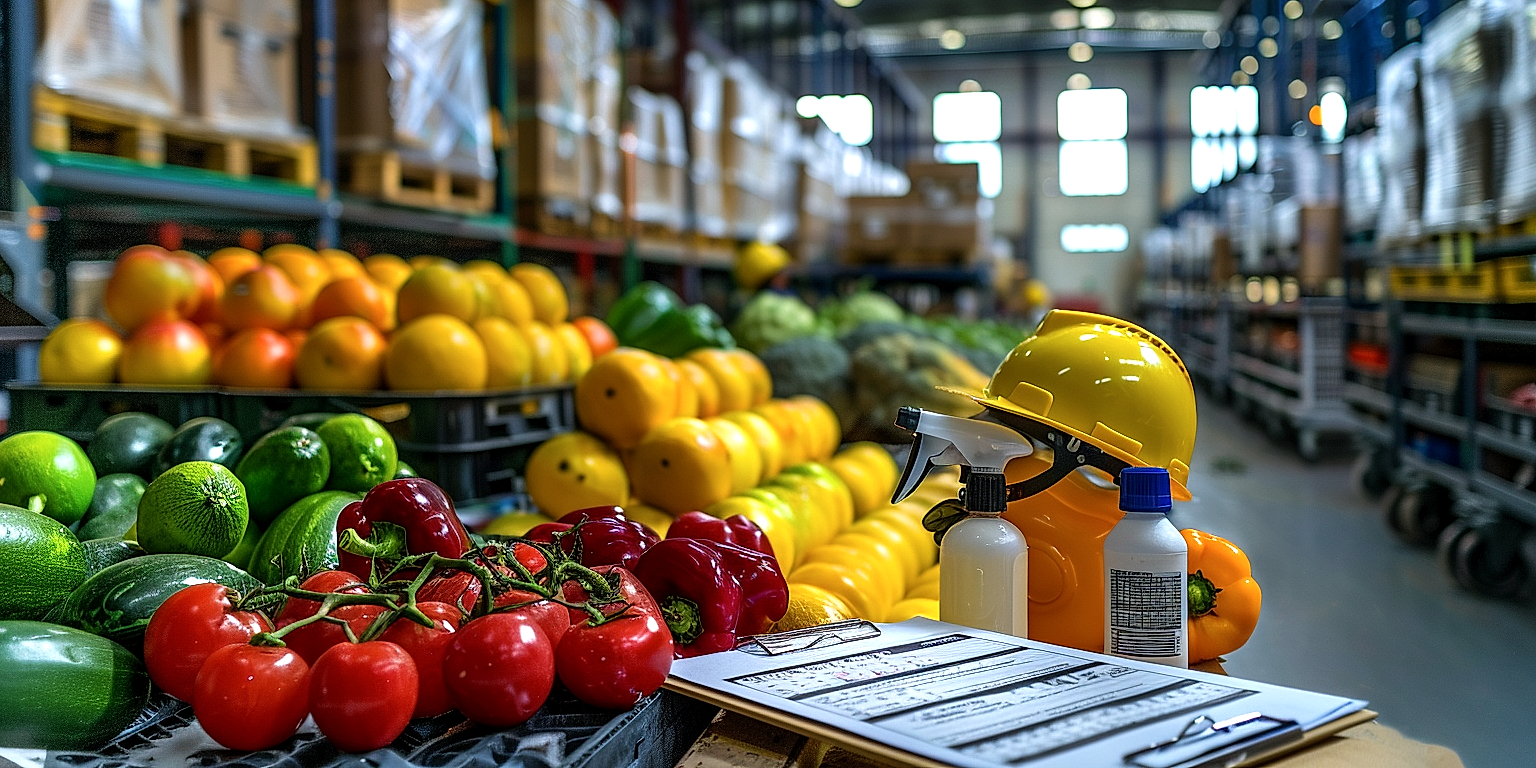Ensuring the safety and well-being of personnel is not just a legal obligation, but an integral part of business sustainability.
In the field of produce distribution, creating a safe environment for workers can be challenging due to the intricacy of handling and distributing perishable items.
Therefore, it becomes essential to have comprehensive employee safety training in place.
The aim is to hone their skills, boost their understanding of safety regulations, and help prevent potential workplace accidents.
In this context, a diverse range of topics must be covered, catering to every aspect of the work involved.
This helps garner a holistic view to enhance overall operational efficacy in the long run.
Contents
- Employee Safety Training Topics For Produce Distribution
- 1. Safe Handling of Fresh Produce
- 2. Chemical Safety in Produce Distribution
- 3. Forklift Operation and Safety
- 4. Fall Protection and Prevention
- 5. Cold Storage Safety Measures
- 6. Personal Protective Equipment Training
- 7. Safe Manual Lifting Techniques
- 8. Emergency Evacitation Procedures
- 9. Hygiene and Sanitation Procedures
- 10. Fire Safety and Extinguisher Use
- The Bottom Line
Employee Safety Training Topics For Produce Distribution
1. Safe Handling of Fresh Produce
The first step in ensuring the safe handling of fresh produce begins with understanding the risks involved in not doing so.
These risks may include the spread of foodborne illnesses, potential injury due to mishandling equipment, and deterioration of the produce quality.
In order to mitigate these dangers, employees must be thoroughly trained on safe handling procedures.
Employee safety training is a fundamental aspect of the produce distribution industry to assure both the safety of workers and the quality of the produce.
This training should include detailed instructions on how to properly pick up and carry produce to prevent injuries and bruising.
Moreover, it should also cover the correct usage of equipment such as knives and slicing machines when preparing produce for distribution.
There are specific ways to handle different types of produce, and staff needs to be educated on these specific techniques.
For example, some kinds of produce may require gloves or other types of protective equipment when being handled.
In addition, fruits and vegetables are susceptible to temperature changes and must be stored and transported correctly to preserve their freshness and prevent spread of bacteria.
To do this, employees should know how to monitor and maintain the right temperature levels in coolers and transport vehicles.
Moreover, they must also be informed about regularly cleaning and sanitizing storage spaces to avoid contamination.
It is also critical to understand the potential hazards from pesticides and other chemicals that might be on the produce.
Training on how to effectively clean produce to remove residues is essential to prevent health issues.
The safe handling of produce also extends to the management of produce waste which, if not handled correctly, can become a breeding ground for pests and diseases.
Workers should be trained on how to properly dispose of waste and maintain a clean and safe working environment.
Lastly, let’s underline the fact that safe handling practices not only ensure the safety of the employees but also improve the quality of the produce, customer satisfaction and the overall success of the produce distribution business.
2. Chemical Safety in Produce Distribution
The use and management of chemicals in the produce distribution industry plays a crucial role in ensuring safety for employees.
While certain chemicals are necessary for cleaning, disinfection or pest control, their misuse or mishandling can pose significant risks.
A clear understanding of Chemical Safety Data Sheets (CSDS) is essential as these contain vital information on correct usage, storage, and disposal of chemicals.
Staff should be trained to store hazardous substances properly, ensuring they are clearly labeled and stored away from food products.
Providing adequate Personal Protective Equipment (PPE) can significantly mitigate the risks associated with chemicals.
Ensure the availability of chemical-resistant gloves, goggles, and aprons to protect against spills or splashes.
Appropriate ventilation is key to preventing the buildup of harmful fumes in the work environment.
Staff education is vital to recognize the signs of chemical exposure, including nausea, dizziness, skin or eye irritation, and difficulty breathing.
In cases of chemical exposure, knowing how to properly use first aid equipment and procedures can save lives and prevent serious injuries.
Correct chemical disposal processes should also be emphasized to protect the waste handlers and the environment from harm.
Employees should be trained to handle emergency situations involving chemicals, including understanding how to use emergency shower and eye wash stations.
Communicating the importance of reporting all chemical accidents and near misses is key in preventing future incidents.
Aside from training, routine checks on chemical storage areas and continuous monitoring of the workplace environment are important steps in maintaining safety.
Chemical safety management in produce distribution is not a one-time task, but an ongoing process that requires vigilance, communication, and continuous learning.
Ultimately, the goal is to provide a safe and healthy work environment for every employee involved in the process of produce distribution.
3. Forklift Operation and Safety
Facilitating the safe operation and handling of forklifts is a critical aspect of safety training programs for employees involved in produce distribution.
Not only is this important for preventing injury to the operators themselves, but it also reduces the risk of harm to other employees in the vicinity, as well as avoiding damage to important warehouse infrastructure and produce inventory.
A crucial step in this training is teaching forklift operators how to conduct a proper pre-operational check.
Familiarizing employees with the different controls and functionalities of a particular forklift model is another paramount aspect of safety training.
The significance of maintaining a clear vision of the path and avoiding speeding are practical measures that employees need to comprehend and practice.
Besides, the employees must understand the importance of wearing the appropriate personal protective equipment (PPE) while operating a forklift, which may include hard hats, safety boots, and high-visibility clothing.
The need for adequate training and certification before an employee is permitted to operate a forklift cannot be overemphasized.
Topics like load stability and capacity, navigating slippery or unstable surfaces, and dealing with pedestrian traffic in the warehouse are also crucial parts of forklift safety.
The forklift operators must have a profound understanding of the machine’s weight capacity limits to avoid toppling due to overloading.
They also need to be trained on how to respond in the event of an emergency or accident, including practices for evacuation and emergency stops.
Procedures for reporting any observed defects or issues with the forklifts, highlighting the importance of regular maintenance to ensure they are always in safe working condition, form another important part of forklift safety training.
Furthermore, proper parking procedures, such as lowering the forks to the ground and turning off the engine, play a crucial role in preventing unintended movement or damage.
Lastly, safety training should cover aspects related to safe fueling or charging practices of forklifts to prevent fires, explosions, or other safety hazards.
Implementing rigorous and thorough forklift safety training goes a long way in minimizing accidents, reducing downtime, and improving overall operational efficiency in the produce distribution environment.
Moreover, it reinforces the company’s commitment to maintaining a safe and healthy workplace for its employees.
4. Fall Protection and Prevention
When dealing with produce distribution, employee safety remains paramount, particularly when working at elevated heights.
To avoid accidents relating to falls, it’s essential to equip employees with the right knowledge about fall protection and prevention.
Understanding the importance of fall protection and prevention can drastically reduce the risk of work-related accidents in the produce distribution industry.
An effective strategy is through the implementation of proper safety training, highlighting the best practices in terms of fall protection.
These trainings should encompass the different facets of fall prevention, from maintaining a clean work environment to employing the appropriate safety gear.
For instance, wearing the proper footwear can significantly reduce slipping risks, a leading cause for falls in the workplace.
Moreover, effective communication is vital in preventing falls, allowing staff to alert others about potential slip, trip, or fall hazards.
Providing adequate lighting and signage can also aid in preventing accidents, as staff can easily identify potential fall hazards.
Furthermore, regular checks on the condition of tools and equipment are essential to make sure they are reliable and safe for use.
Proper ladder use forms a key part of training programs, with employees being schooled in ladder safety tips such as maintaining three points of contact.
In addition to these, understanding the required safety standards established by regulatory bodies is crucial.
This involves in-depth training on how to properly use personal protective equipment (PPE), such as safety harnesses, when working at heights.
Ultimately, the goal is to promote a safety-conscious culture within the produce distribution industry, where employees understand the risks associated with their work environments and can take necessary precautions accordingly.
It is indeed beneficial to have safety programs on fall protection and prevention tailored to the specific needs of the produce distribution industry.
Emphasizing the importance of fall protection and prevention can help create a safer working environment, minimize productivity losses due to injuries, and ensure the overall well-being of employees.
The active involvement of both management and staff in these training exercises helps to cultivate a safety-driven work environment essential for the smooth running of the operation.
5. Cold Storage Safety Measures
Within the domain of produce distribution, the aspect of cold storage safety cannot be overemphasized.
Employees must be adequately versed with all the key elements associated with the safe operation and maintenance of cold storage facilities.
The importance of maintaining the right temperature in cold storage is essential not just for food safety but also for ensuring employee safety.
Training employees on regular checks and maintenance of temperature control systems is crucial for the longevity of the produce as well as safety within the cold storage area.
Staff should be trained on recognizing and dealing with potential hazards that can stem from malfunctioning refrigeration systems.
The risk of carbon dioxide buildup and oxygen depletion in cold storage facilities is a potential danger that must never be undermined.
Detailing protocols for regular air quality checks and establishing emergency procedures in case of elevated CO2 or decreased oxygen levels must be a part of the safety training.
Along with this, all employees entering the chilly premises must wear the appropriate cold weather personal protective equipment, such as thermally insulated gloves, footwear, and headgear.
Another vital aspect to cover in cold storage safety training is the possibility of cold-related illnesses or injuries such as hypothermia or frostbite, and their prevention.
Guidance on regular staff health checks and first aid procedures for these specific cold-related ailments should be given.
In addition, potential slip, trip, and fall hazards are much more prevalent in cold, wet environments and proper training should be provided on slip prevention techniques and the importance of maintaining clutter-free floors.
One must also train the staff on safe manual handling techniques specific to cold conditions as the freezing temperatures can impact grip and overall dexterity.
Another aspect to include in the training is educating the staff on the suitable storage and stacking techniques to prevent toppling over of products and the resulting injuries.
Above all, it is important to foster an environment where employees feel safe to report any potential hazards or safety concerns in their workplace.
By ensuring comprehensive safety training on the above-mentioned points, employers can create a safer and healthier workplace environment in produce distribution.
6. Personal Protective Equipment Training
Personal Protective Equipment (PPE) is a crucial aspect of safety in the workplace, particularly in the produce distribution industry.
Used correctly, PPE can significantly reduce the risk of injury and illness.
PPE includes items like gloves, safety shoes, helmets, goggles, high-visibility clothing, and respiratory protective equipment.
For it to be effective, employees must be properly trained on how to use and maintain this equipment.
That’s why PPE training is a necessary part of employee safety training.
Through PPE training, employees learn the usage, maintenance, and importance of each piece of equipment.Training also includes instruction on how to properly don and remove PPE to avoid contamination.
It’s essential that training is practical and not just theoretical.
Employees should be allowed to practice wearing and using the PPE under the close guidance of a trainer.
This ensures they gain first-hand experience and are more likely to use the PPE correctly in the workplace.
Furthermore, PPE training should emphasize the consequences of not using or incorrectly using PPE.
This helps to instill a sense of responsibility and accountability in the employee for their own safety and those around them.
Employers also have to guarantee the PPE provided is of good quality and correctly fits each employee.
To summarize, correct usage of PPE can only be achieved with comprehensive instruction, real practice, and employee understanding of its importance.
Proper PPE training is, therefore, a must in any produce distribution environment to ensure worker protection.
7. Safe Manual Lifting Techniques
Safe manual lifting techniques are vital not only to prevent injuries but also to increase efficiency and productivity in a produce distribution setting.
In the field of produce distribution, employees are consistently required to lift heavy objects, such as boxes of fruits and vegetables, onto a forklift or a truck for delivery.
Without the proper training in manual lifting techniques, these employees could potentially suffer from serious physical injuries including strains, sprains, and hernias.
An important component of safe manual lifting techniques is understanding the body mechanics involved in this process.
The main principle is to always lift with your legs, not your back, as it reduces the risk of back injuries significantly.
Ensuring that feet are shoulder-width apart, bending at the knees, keeping the load close to the body, and lifting with the legs rather than the back, are all part of proper body mechanics when lifting.
Additionally, employees should avoid twisting their bodies when lifting and instead should turn their whole body, feet first.
The use of mechanical aids, like hand trucks, wheelbarrows, and forklifts can help reduce the strain on the body from lifting heavy loads and should be encouraged wherever possible.
Moreover, exercises strengthening core muscles are also beneficial to counter the physical strain of manual lifting and should be encouraged as part of a holistic approach to safety.
However, safe lifting is not simply about technique and strength, it also involves judgment about what is safe to lift manually and what is not.
Employees should be trained to assess the weight and stability of a load before attempting to lift it.
If the load is too heavy or unstable, they should be encouraged to seek assistance or to use a mechanical aid.
It’s crucial to foster a workplace culture that prioritizes safety and health, where workers feel comfortable asking for help or refusing to lift something if they feel it is unsafe.
Regular training and reinforcement are key to ensure the manual lifting techniques are properly understood and applied, and that safety becomes second nature in the day-to-day operations.
Overall, safe manual lifting techniques reduce the risk of injury, increase productivity, and create a safer, healthier workplace environment in the produce distribution industry.
8. Emergency Evacitation Procedures
All workplaces, including produce distribution centers, should have a well-planned Emergency Evacuation Procedure.
This ensures the safety of all employees in case of an emergency or disaster.
Make sure all the evacuation routes are clearly marked and unobstructed at all times.
In the event of an emergency, employees must be trained to stay calm and follow the evacuation procedures without panicking.
Regular and unexpected drills should be conducted to ensure that employees are familiar with the evacuation routes and procedures.
A trained emergency response team should be established who will assist in the safe and orderly evacuation of employees.
All employees should be trained to recognize the different alarms and annunciators and what they mean.
Before an actual evacuation, the employees should turn off their workstations if it is safe to do so.
Head counts needs to be taken at the assembly points to ensure all employees are accounted for.
An clear communication system should be established to convey any necessary information to the employees at the assembly point.
If an employee is missing, the search and rescue team should immediately be notified.
The evacuation procedure should also include the plan for employees with disabilities.
Employees should be instructed to move away from the building after reaching the assembly point.
During an evacuation, employees must not use elevators.
They should also not re-enter the building unless declared safe by the officials.
9. Hygiene and Sanitation Procedures
Hygiene and sanitation are critical aspects of maintaining safety in produce distribution.
The prevention of contamination of fresh produce is a crucial health aspect of both workers and consumers.
Consistent maintenance of sanitary practices is necessary for ensuring the wholesomeness and quality of the food supply.Include personal cleanliness, regular hand washing, and the use of clean and appropriate clothing among basic hygiene practices.
Sanitation procedures involve the maintenance of clean and sterile environments for handling and storing products.
Staffs should be trained on a wide range of sanitation procedures, including proper cleaning of surfaces, utensils, and machinery.
Produce washing is a significant aspect of sanitation in produce distribution, designed to remove potential contaminants.
For effective sanitation, it is crucial to regularly disinfect high-touch areas that may harbor harmful microorganisms.
All employees should understand the importance and application of food-grade sanitizing agents when washing and cleaning surfaces and utensils.
There should be a detailed sanitation schedule in place to ensure that cleaning and disinfecting procedures are consistent and thorough.
Preventing cross-contamination is paramount, thus the separation of raw produce from other items during storage and distribution should always be observed.
Waste management is another component of sanitation procedures in a produce distribution facility.
The proper disposal of trash and waste materials helps prevent the spread of harmful pathogens and pests, keeping the environment safe and clean.
The production and storage areas should have adequate ventilation, temperature, and humidity control to prevent growth of bacteria and molds.
Employees should understand that breaches in hygiene and sanitation protocols can lead to severe consequences, including food illness outbreaks.
10. Fire Safety and Extinguisher Use
Understanding and practicing fire safety principles is paramount in ensuring employee safety within a produce distribution center.
The ability to identify potential fire hazards and the knowledge to handle them when they occur can significantly reduce the risk of property damage and personal injury.
A basic aspect of fire safety involves maintaining clean and clutter-free workspaces, and ensuring that electrical equipment and machinery are in good working condition.
Being aware of the locations of fire exits and evacuation routes can make a huge difference during a fire-related emergency.
Employees should also be taught how to properly operate a fire extinguisher because in the event of a small fire, it may be the first line of defense.
Understanding the PASS method (Pull, Aim, Squeeze, Sweep) of extinguisher use is a crucial part of this training.
Not all extinguishers are the same, anyone working in the facility must be knowledgeable of the different types of fire extinguishers and which type is best suited for different scenarios.
Furthermore, all employees should be informed about the limitations of a fire extinguisher and understand that they are not designed to combat large, out-of-control fires.
In such scenarios, the immediate step is to implement the evacuation plan and allow professional firefighters to deal with the situation.
Training should also cover the proper way to alert others during a fire emergency which may include activating the fire alarm system before initiating evacuation.
Weekly fire drills are recommended to ensure all employees understand what to do in the event of a fire.
Distribution centers should also enforce a strict no smoking policy inside the premises which reduces potential fire hazards.
Fire safety policies and procedures should be uniformly enforced and adhered to by everyone in the organization.
Lastly, a well-maintained and regularly serviced fire equipment will ensure its effectiveness during an actual emergency.
Remember that in every emergency situation, preserving human life should always be the first priority.
The Bottom Line
Despite the intricate tasks involved in produce distribution, safety remains an indispensable aspect.
From ensuring the safe handling of fresh produce and observing chemical safety, to forklift operation and fall protection, meticulous precautions need to be applied.
Additionally, the significance of having a well-equipped cold storage and providing staff with personal protective equipment training cannot be overstated.
Furthermore, instilling safe manual lifting techniques, setting up a comprehensive emergency evacuation process, and adhering to stringent hygiene and sanitation are crucial elements.
Lastly, fire safety, which includes extinguisher use is also crucial.
Ultimately, in every step of the produce distribution process, safety must remain paramount, ensuring that both the employees’ welfare and the quality of the products are uncompromised.




